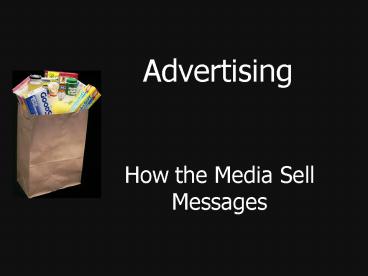Advertising PowerPoint PPT Presentation
1 / 35
Title: Advertising
1
Advertising
- How the Media Sell Messages
2
Definition
- Advertising is any paid form of non-personal
presentation and promotion of ideas, goods or
services by an identified sponsor. - American Marketing Association
3
Origins
- Advertising comes from the Latin word
advertisen, meaning to notify.
4
The reach
- Each day, the average American encounters
approximately 3,000 advertisements, from
broadcast messages to signs and billboard ads.
5
Timeline
- 50 A.D.City of Pompeii, part of the Roman
Empire, posts advertising commonly on buildings. - Post-Gutenberg Era (1456- ) Goods advertised
through printed flyers.
6
- 1625First newspaper ad appears in England.
- Colonial America (1620-1776)Printers of village
gazettes and books use print to advertise their
products. - 1830Start of American Industrial Revolution
draws people to cities where goods are created
and sold, making advertising necessary. - 1840sAdvent of railroads allows goods to be
shipped over great distance, creates demand for
advertising.
7
- P.T. Barnum, an 1860s circus showman and museum
owner, is credited with being the founder of
modern spectacle and mass culture. He knew
inhibited Victorians needed diversion, and he
marketed curiosities to the masses.
8
Industry Founders
- 1841Volney Palmer starts first ad agency in
Philadelphia, representing publishers who needed
advertisers. - 1871N.W. Ayer Son becomes first modern
agency, representing sellers of goods, not
publishers.
9
- Late 19th Century--P.T. Barnum, owner of the
circus he called The Greatest Show on Earth, is
considered the Father of Advertising.
10
- 1880sWith advent of electricity, many products
hyped falsely as being electrified - Electric hairbrush
- Electric corset
- Electric eyeglasses
11
- 1890sBrand name advertising begins as a means of
distinguishing between similar competing
products. - Smith Bros. Cough Drops (first product package at
factory) - Pears Soap (first attempt to establish brand
with quality) - Uneeda Biscuit (first cracker not sold in a
barrel but in a tin.)
12
Top 10 Brand Icons Ever
13
- 1900Start of slogans associated with products.
- Good morning, have you used Pears today?
- Winston tastes good like a cigarette should.
- Coca-Cola. Its the Real thing.
14
Top 10 Ad Slogans of the 20th Century
- Diamonds are forever (DeBeers)
- Just do it (Nike)
- The pause that refreshes (Coca-Cola)
- Tastes great, less filling (Miller Lite)
- We try harder (Avis)
15
- 6. Breakfast of champions (Wheaties)
- 7. Does she ... or doesn't she? (Clairol)
- 8. When it rains it pours (Morton Salt)
- 9. Where's the beef? (Wendy's)
- 10. Good to the last drop (Maxwell House)
16
HONORABLE MENTIONS
- Look Ma, no cavities! (Crest toothpaste)
- Let your fingers do the walking (Yellow Pages)
- Loose lips sink ships (public service)
- MMs melt in your mouth, not in your hand (MM
candies) - We bring good things to life (General Electric)
17
Top Jingles of 20th Century
- You deserve a break today (McDonalds)
- Be all that you can be (U.S. Army).
- Pepsi Cola Hits the Spot (Pepsi Cola).
- M'm, M'm good (Campbell's).
- See the USA in your Chevrolet (GM).
18
- 6. I wish I was an Oscar Meyer Wiener (Oscar
Meyer). - 7. Double your pleasure, double your fun
(Wrigley's Doublemint gum). - 8. Winston tastes good like a cigarette should
(Winston). - It's the Real Thing (Coca Cola).
- Brylcreem-- A little dab'll do ya
19
- 1906Congress passes the Pure Food and Drug Act,
the first legislation to protect consumers. - 1914Federal Trade Commission established.
20
- 1925President Calvin Coolidge observes that
mass advertising creates mass demand and is
necessary to a manufacturing economy. - Advent of radio turns ad slogans into jingles.
21
Growth of Ad Revenue
- 1947
- 1970
- 1980
- 1983
- 2000
- 4 billion
- 20 billion
- 50 billion
- 75 billion
- 236.8 billion (52 of world advertising)
22
- Post-WWII eraUshered in the following that was
beneficial to ad industry - Baby Boom
- Economic Affluence
- TV
- Psychological techniques of persuasion learned
from war propaganda.
23
Ad Expenditures by Medium (1995)
24
- 1950s--Unique Selling Proposition (USP) developed
by Ted Bates Company, which sought to use an ad
to differentiate between products that had no
difference.
25
- Brand Image developed by David Ogilvey, a major
influence in American advertising. Sought to
associate images with products that made them
appeal more than others. - Ralph Lauren
- Tommy Hilfiger
- Jeep
26
- 1950sFirst use of motivational research, started
by Ernest Dichter, and reported in Vance
Packards book The Hidden Persuaders. - Subliminal advertising tried by researcher Jim
Vicary.
27
Methods today
- Advertisers tailor messages to audiences based
on - Demographics (audience characteristics)
- Psychographics (audience values, moods, opinions)
28
- 1983NAB Code abandoned after court ruling finds
restrictions violate anti-trust laws.
29
- 1990sAdvertisers discover the World Wide Web
- Total ad dollars on Web--43 billion by 2005, 30
billion from the U.S. alone. - Studies show a correlation between Web-based
advertising and purchasing. - One study indicates that banner ads increase
offline advertising by 19
30
(No Transcript)
31
(No Transcript)
32
(No Transcript)
33
(No Transcript)
34
(No Transcript)
35
Trends
- More online ads
- Growth in Direct Mail
- Decrease in newspaper ads
- Shorter TV commercials
- Infomercials
- Place-based advertising

